
A “quickie” this weekend. Hopefully, weekend longforms will return soon, though (thankfully?) I’m thinking the days of my 100-photo epics are done. I don’t travel much: when I have the money I don’t have the time, and vice versa. Sergey and his family, though, travel frequently and found themselves at JFK Airport recently.

SINCE its opening in 1942, JFK International Airport has undergone many names and buildings. Amid the ongoing transformation, if one knows where to look, there are artworks relating to its past. One such example is the panel outside the men’s restroom at Terminal 8. It honors Robert Sowers’ iconic glass facade that decorates the American Airlines terminal between 1960 and 2008.
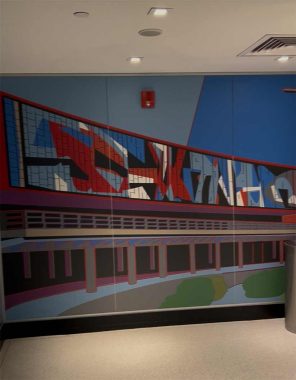
At the time of its completion, the work was the longest single expanse of stained glass in the world, stretching 317 feet and nearly 23 feet in height, comprising 10,000 pieces of glass imported from Germany.
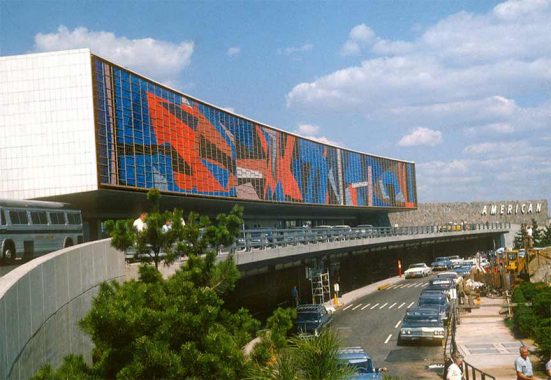
When the terminal was demolished, some admirers of Sowers’ art tried to preserve the window in one piece under the banner Save America’s Window. Failing to raise enough money and without support from American Airlines and the Port Authority, the work was broken up into panels sold by the Scranton-based Olde Goode Glass. They were then sold and reused by buyers far and wide. You can buy a piece of the window for $300.

At the time of the demolition, The New York Times reported that some of the four-foot panes were intended for the Cradle of Aviation Museum in Garden City, the C.R. Smith American Airlines Museum in Fort Worth, and in the new terminal replacing the 1960 building. Another panel ended up at the Madison Museum of Fine Art in Wisconsin.
Why didn’t the new terminal receive stained glass windows to evoke Somers’ design? Because the 1960 terminal’s window was visible from the parking lot and approach roads. The new terminal’s windows face a taxi dropoff canopy, Airtrain station and parking garage, hardly visible from the outside.
Although most of the public art here is dedicated to American Airlines, the terminal also hosts British Airways, Alaska, Cathay Pacific, China Southern, Finnair, Hawaiian, Iberia, Japan Airlines, Level, Qantas, Qatar, and Royal Jordanian.
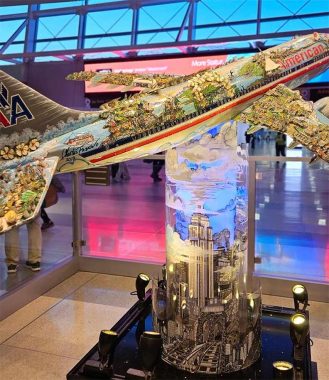
On my visit to Terminal 8, I found many artworks in the building, including a Queens-themed mural by Jedidiah Dore, pop art installations by Charles Fazzino, among others.
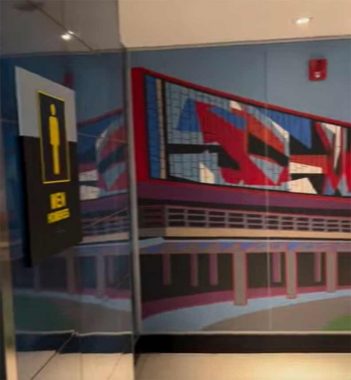
But I did not see any remnants of Sowers’ great window in the new Terminal 8, only a panel depicting it outside the men’s room as I awaited my vacation flight out of New York. If you’ve seen it here, the comment section is open.
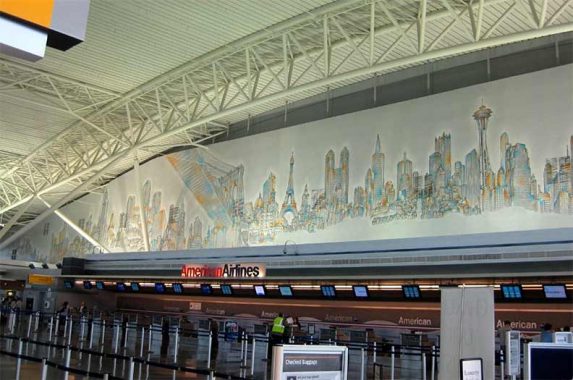
Visitors who are not flying out of Terminal 8 can only go as far as the entrance lobby, which appears dark at night beneath the massive metal canopy. Taking Sowers’ place as the terminal’s defining artist, Matteo Pericoli’s Skyline of the World takes up a full-length wall at 397 feet, depicting architectural landmarks from 70 cities around the world. Inevitably, the present terminal may also face the demolition crew in the future. Will this mural also become the subject of a preservationist effort?
If you want to experience the airport of the 1960s, the nearby TWA flight Center isn’t going anywhere. It is here to stay as a hotel. The airport is also home to a rare species of lamppost.
Sergey Kadinsky is the author of Hidden Waters of New York City: A History and Guide to 101 Forgotten Lakes, Ponds, Creeks, and Streams in the Five Boroughs (2016, Countryman Press), adjunct history professor at Touro University and the webmaster of Hidden Waters Blog.
Check out the ForgottenBook, take a look at the gift shop. As always, “comment…as you see fit.” I earn a small payment when you click on any ad on the site.
5/17/25

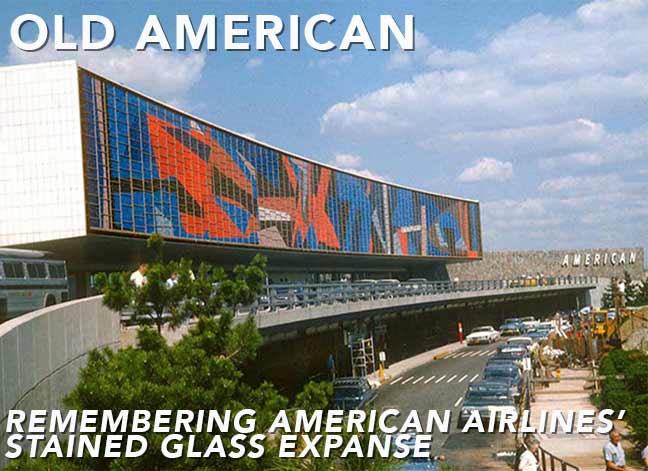
6 comments
Reminds me of the Paramus NJ Alexanders Department Store mural. I believe most of the Alexanders panels are still intact, somewhere near where they were originally displayed.
https://media.nj.com/entertainment_impact/photo/alexanders-mural-paramus-stefan-knapp.jpg
That artwork of a jet encrusted with various growths is hideous. They look like marine barnacles that you would see on an abandoned unkept ship. The last thing you ever want to see on the sleek fuselage of a plane is an imperfection like that. That decision to have that particular art where travelers, who are often nervous about air travel, can see it was terrible and insensitive, to say the least.
Scrolling through the article I saw that ugly ‘artwork’ jet and quickly thought it was the patched up Flight 800. I was mortified for a few seconds until I looked closer and realized they were flowers and yes the flowers do look like barnacles and I know that Flight 800 was TWA. It was still a quick shock and It wouldn’t surprise me that some goofball ‘artist’ would do it.
The TWA Hotel is so much better than Terminal 8. Terminal 8 disrespects the American Airlines Boeing 707 while the former TWA terminal celebrates great architecture that lives on as a hotel; the acquisition of the that magnificent TWA Lockeed Super Constellation is the jewel in the crown that is a tribute to excellence in archeteture & aircraft.
As I remember, the stained glass expanse could not be seen from inside the terminal, so a visit to the terminal was anticlimactic.
FYI, Olde Goode Glass is owned by Olde Good Things, which, bizarrely, is run by a religious cult, the Church of Bible Understanding: https://en.wikipedia.org/wiki/Church_of_Bible_Understanding